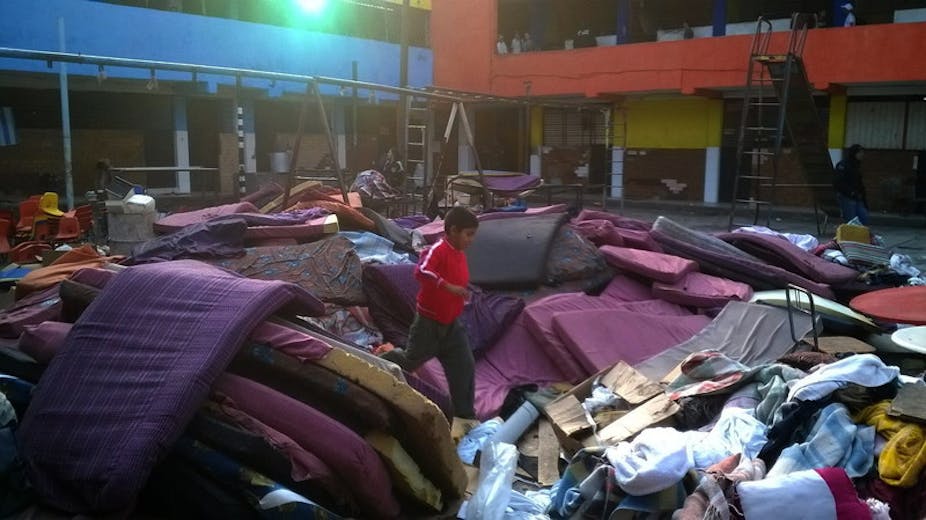The recent rescue of 458 children and 138 adults from the Gran Familia refuge in the city of Zamora in the state of Michoacán is another grim illustration of the plight of many unprotected and vulnerable minors in Mexico.
Among the victims were children who had been reported as having disappeared. Many were held against their will, forced to work and sexually abused. Residents slept on the floor among rats, insects and other pests. The sanitary conditions in the home were reportedly so bad that the authorities had to fumigate the building following the release of the residents.
Mexico’s politicians and mainstream media tend to represent cases like the Gran Familia in isolation. But if the news emerging from Michoacán is disturbing, it points to a generalised context which is even more unsettling.
The scale of this latest rescue is highly unusual – but the poor conditions and abuses suffered by children in Mexico and Central America are signs of much wider structural problems.
Radical reform
Mexico’s increasing instability and social crisis have been caused in large part by 30 years of sweeping economic reforms, which have overwhelmingly benefited a wealthy minority. The state has all but abdicated its responsibility to provide protection to minors at risk.
Among the most vulnerable are those with disabilities or who have been abandoned by their parents, but increasing numbers of children in Mexico are seriously exposed in an environment that leaves the poor and the defenceless to fend for themselves – putting them at the mercy of corrupt institutions and criminal gangs.
Providing essential services to minors at risk is a low priority for the government of Enrique Peña Nieto, which is currently embarked on a radical campaign of “modernisation”, privatisation and austerity. The officials behind the economic policies pushing more and more Mexicans into poverty clearly prefer to ignore the fact that millions of children have been robbed of a childhood.
Poverty lines
Mexico is rich in resources, and has a well-developed manufacturing base. It is the world’s sixth largest producer of oil and its 14th largest economy; yet still, one in every 10 Mexican minors has to work to survive. Almost half of these do not receive a salary and/or are engaged in labour that endangers their health and safety.
Mexico’s population is a young one; it currently has about 40m minors. More than half of these children live in poverty; over 21m children have little or no access to goods and essential services.
Poverty in Mexico is also demarcated by strong racial and ethnic lines: almost 80% of children from indigenous communities live below the poverty line, and about one in three lives in extreme poverty.
Mexico has seen some economic growth over the last few years, but growth does not improve the conditions of those living in economic hardship if the distribution of wealth always favours the rich. Similar trends have developed in the Central American countries, with equally, if not more disastrous, results.
Refugee crisis
Partly as a result of this ongoing decline, mounting numbers of children are attempting to flee worsening social conditions and living standards and an increase in violent crime. This has led to a massive refugee crisis, with tens of thousands of unaccompanied Mexican and Central American children attempting to migrate to the United States; since October 2013, US border patrol agents have detained around 57,000 unaccompanied children from Mexico and Central America.
These children travel hundreds and even thousands of miles in order to join family members – themselves economic refugees – already in the US. Often they have little more than a phone number or name of a county with which to locate family should they make it across the border.
The journey north through Mexico aboard the roof of freight trains, referred to as la Bestia or the Beast, is commonly regarded as one of the most dangerous journeys in the world. Criminal gangs, often working in collaboration with the police, regularly rob, assault, rape and kill children travelling this way. Some lose limbs or die when they fall between the wheels of the train in their sleep; others are thrown off.
Mexico is legally obliged to protect its own citizens and foreign nationals travelling through its territory, but in practice this means very little. Operating in a climate of impunity, the judicial system fails to prosecute almost all the perpetrators of violent crime. Around 1 in 10 violent crimes is reported in Mexico, and of those, only about 1.5% ever lead to prosecution.
It is therefore not difficult to understand that children – especially the poor – are especially at risk from all manner of abuse, sexual violence, forced labour and other forms of economic exploitation.
The plight of millions of children who have been abandoned by the state is completely at odds with the glossy, stage-managed PR of the Nieto government. Unless structural reforms are introduced to help the poor instead of making concessions to big business and multinational corporations, the number of children living like those at the Gran Familia, or risking life and limb to seek refuge in the US, will only continue to grow.

